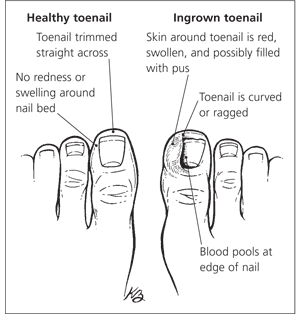
Am Fam Physician. 2009;79(4):311-312
See related article on ingrown toenails.
What is an ingrown toenail?
An ingrown toenail is when the edge of your toenail curves down and pokes into the skin.
Who gets ingrown toenails?
Anyone can get them, but teenagers and older people get them more often. Teenagers get them because their feet sweat more, which can cause the skin and nails to become soft. Soft nails split easier. Pieces that split can easily puncture the skin. Older people get them because they have trouble caring for their feet.
Ingrown toenails also can happen to people who try to “round off ” the corners of their toenails with a nail file. Trauma (for example, stubbing your toe, running, or kicking objects) can also cause them. Ingrown toenails sometimes run in families.
How do I know if I have one?
You may have pain or swelling. The skin around the toenail can also get red. As the ingrown toenail gets worse, the pain and redness get worse. Sometimes, it becomes infected. It may bleed or have pus (see drawing). An ingrown toenail may also limit the activities you do every day, like sports or walking.

How are they treated?
Most ingrown toenails can be treated by soaking the foot in warm, soapy water and applying a topical antibiotic ointment, such as polymyxin/neomycin (one brand: Neosporin). Your doctor can also put cotton wisps, dental floss, or splints under the edge of the ingrown toenail between the toenail and the skin. You should not try to cut or remove the ingrown part of the nail yourself.
Tell your doctor if you have a lot of pain or think it may be infected. You may need surgery to remove the ingrown part of the nail or the whole nail. Your doctor may also destroy the nail bed so that the ingrown toenail does not come back. Be sure to tell your doctor if you may be pregnant because some chemicals used to destroy the nail bed should not be used in women who are pregnant or breastfeeding.
How do I care for my toe after surgery?
You should rest and elevate your foot for the first 12 to 24 hours after surgery. If your toe is sore, some medicines (for example, acetaminophen [one brand: Tylenol] or ibuprofen [one brand: Motrin]) may help. Two days after surgery, you should begin soaking your toe in warm, soapy water three or four times a day. Then, you should put on an antibiotic ointment and a clean bandage. You should continue to do this process for one or two weeks after surgery. Tell your doctor if you still have pain, redness, or pus draining from the toe. These are signs that the infection has gotten worse. In this case, you may need to take antibiotics.
How can I prevent ingrown toenails?
When trimming your toenails, cut the nail in a straight line. Do not round off the corners. Be sure to wear shoes that fit correctly.
Where can I get more information?
Your doctor
American Academy of Family Physicians
Web site: https://familydoctor.org